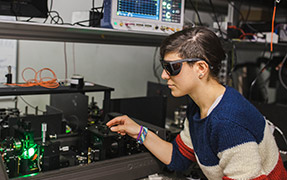Schottky-barrier Solar Cell
Journal of Photonics for Energy article shows improved power-conversion efficiency.
Scientists working to develop affordable and efficient solar panels have developed a new design that early simulations predict will increase power-conversion efficiency more than 25%.
Tom Anderson and Tom Mackay of the University of Edinburgh and Akhlesh Lakhtakia of Pennsylvania State University described their model in “Enhanced efficiency of Schottky-barrier solar cell with periodically nonhomogeneous indium gallium nitride layer,” published in the Journal of Photonics for Energy earlier this year.
Indium gallium nitride (InGaN) possesses optical and electrical properties superior to those exhibited by amorphous silicon. The Schottky-barrier junction of lightly doped InGaN and a suitable metal can easily separate electrons and holes.
In their quest for affordable solar cells, the authors designed a Schottky-barrier solar cell wherein the proportions of indium and gallium were varied periodically in the direction perpendicular to a periodically corrugated metallic back reflector.
Their first-principles optoelectronic simulations predicted a relative increase of 26.8% in device power-conversion efficiency attributed to enhanced electron-hole-pair generation. This was the result of improved optical coupling to guided-wave modes arising from the periodic nonhomogeneous film of InGaN, without proportional enhancement of electron-hole recombination.
The open access article is in the SPIE Digital Library.
 –SPIE Fellow Zakya Kafafi is founding editor and editor-in-chief of the Journal of Photonics for Energy.
–SPIE Fellow Zakya Kafafi is founding editor and editor-in-chief of the Journal of Photonics for Energy.
- Have a question or comment about this article? Write to us at spieprofessional@spie.org.
- To receive a print copy of SPIE Professional, the SPIE member magazine, become an SPIE member.



